Rural users switch as low cost Starlink plan take off

Starlink makes waves in rural New Zealand
Three weeks after it launched, (Download Weekly March 15) Starlink’s low-cost satellite broadband plan is making waves with frustrated rural telecoms users.
Starlink describes its $79 plan as a ‘deprioritised service’. It means that, should the network be congested, customers on the plan will be behind those who pay full price ($179) in the queue for bandwidth.
Most of the time the network is not congested in New Zealand. Early users report getting speeds of between 200 and 300 mbps on the deprioritised plan.
Starlink beats most rural fixed wireless
This is far in excess of most rural fixed wireless broadband speeds. Starlink latency can be as low as 20ms, which for most apps is negligible.
In other words, Starlink performance, even when deprioritised, is closer to low-end fibre broadband than fixed wireless.
To date there have been few public complaints that the deprioritised nature of the connection causing drop outs during peak times. This may change as more customers sign up for the service.
Hundreds are switching to Starlink
Anecdotal evidence from regional New Zealand suggests hundreds of users are either switching or in the process of switching from capped, often poor quality, fixed wireless connections to Starlink’s faster, cheaper, uncapped plan.
A similar shift sees people using expensive, older satellite technology moving to Starlink.
Many rural users are on fixed-term plans, which means carriers may not feel the full impact of Starlink’s aggressive price plan until contract renewal time. However, at least one rural user who was on a contract told Download Weekly they switched, paid the break fees and still came out ahead.
More broadband for less money
Another rural user who contacted the Download Weekly following the earlier story about Starlink’s deprioritised plan says they now pay considerably less for a vastly improved service.
Previously they were unable to watch streaming TV services, but have since enjoyed high definition content without interruption — something that was not possible before.
It’s not just fixed wireless customers who benefit from the plan. Existing Starlink customers are switching from the $159 standard plan to the cheaper $79 deprioritised plan. One switcher told Download Weekly they have yet to notice any change in broadband performance.
Starlink’s standard New Zealand plan is expensive by international standards. It charges European users €50 for the same service. Customers in much of the world pay similar prices. The company’s deprioritised plan brings the NZ price more in line with overseas rates.
Predatory pricing?
Starlink’s $79 plan is priced aggressively. A simple analysis of the company’s business model suggests it is close to the long-term breakeven point which analysts suggest is around the US$50 a month mark.
Clearly the strategy is about building market share and momentum. Whatever happens in the satellite market, that is going to hurt rural fixed wireless carriers and Wisps.
If Starlink were to remain the only low earth orbit (Leo) satellite network, it could potentially build a near monopoly position in rural broadband with an opportunity to capitalise on that by raising subscription prices to a captive audience.
This is by no means a certainty. Other Leo networks are under development. Amazon’s Project Kuiper and OneWeb are the most advanced and could start operation within months, however Starlink has at least a two year head start on its competitors and is likely to remain dominant in the near future.
One New Zealand pushes back 3G switch off
One New Zealand says it will now switch off its 3G network at the end of next March. One year from now. The company previously said it would close the network on August 31 this year.
A statement from One NZ says the move is designed to give customers more time to prepare. While it mentions the need for customers to update phones, that’s a relatively simple process compared with upgrading IoT devices and in-vehicle modems which rely on the older technology.
One New Zealand’s erstwhile partner Vodafone Australia switched off its 3G network over the new year holiday and says customers experienced virtually no change in coverage but saw improved network experience.
Digital wallet to fund phone upgrades
One New Zealand says its digital wallet promotion will help customers upgrade phones. The company says it put $37 million into the wallet pool. Customers can then earn extra One Wallet points by trading in old handsets, buying new plans or switching to direct debit. One Wallet points can be used to discount new phone purchases.
“Some consumers have all the bandwidth they need”
Thursday’s CommsDay newsletter (not available online) covers the 2024 Deloitte TMT report which says the need for ever faster broadband bitrates is levelling off.
One highlight: “In some parts of the world, some consumers may have all the bandwidth they need in 2024. They are still expected to want ever better internet connections, just not necessarily faster ones.”
Another nugget suggests that: “In the absence of any new applications or devices that could require significantly more bandwidth, household demand for bandwidth might be reaching its natural ceiling, at about 100 Mbps.”
Comment: That “new application or device” could be virtual reality and hardware like Apple’s Vision Pro headset. It chews through data Although, realistically, the technology will not be mainstream in the immediate future.
In other news...
Chris Keall at the New Zealand Herald looks at the sector’s job losses in: 2degrees the latest telco to cut staff, One NZ confirms about 200 leaving. One NZ, 2degrees, Spark and Chorus have all cut numbers this year.
At The Spinoff Shanti Mathias asks: Supermarkets know everything from your gender to licence plate number. Do you care? The short answer is “probably not as much as you should”.
Newsroom’s Andrew Bevin looks at the stoush between One NZ and 2degrees over rights to spectrum previously owned by Dense Air. What looked like a relatively straightforward decision for the Commerce Commission to rule on over the summer break has now been pushed back to the end of the next month.
Juha Saarinen is turning out some great work at Interest.co.nz. This week he penned a thoughtful essay about the similarities between what is happening with the media and how Uber upset the worldwide transport sector. There are loose parallels here with Starlink’s impact on telecommunications.
